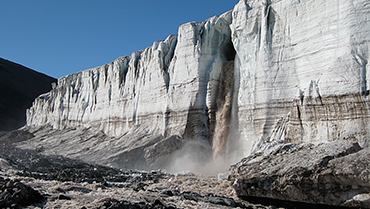Arctic
As part of the Commonwealth of the Realm of Denmark DMI has a long tradition studying, monitoring and forecasting Greenland’s weather, atmosphere, ocean, ice and climate. Further, climate change is more pronounced in the Arctic than almost everywhere else on the globe. It is therefore important to assess potential future Arctic changes using climate models.
Many lines of research at the DMI are centered around the Arctic. DMI is responsible for forecasting the weather, ocean , ice and wave conditions for Greenland, and thus runs numerical weather, ocean-ice and wave prediction models for Greenland and provides official forecasts. DMI participates in a number of climate studies in the Arctic, including coupled atmosphere -ice sheet modelling as well as ocean and sea ice studies with focus on Greenland fjords, the surrounding waters and the Arctic Ocean.

Atmosphere and ocean climate models are run over numerous Arctic domains and coupled atmosphere, ocean, ice sheet and permafrost models are developed. The arctic stratosphere, which is determining for the ozone layer over the Northern Hemisphere, is a long-standing research area at DMI. Finally, DMI researchers are part of the team behind the outreach web site polarportal.org and take part in several expert groups on short-lived climate pollutants (SLCPs) in the Arctic.
Increasing economic activities in the Arctic waters such as maritime transport, offshore oil and gas exploitation and fishery have raised new research challenges such as e-navigation, environmental protection and ice service. Combing modeling, remote sensing and in-situ monitoring, DMI has been actively developing integrated Arctic System science for serving a variety of social benefit areas.
eSTICC: eScience Tools for Investigating Climate Change at High Northern Latitudes (Link: english (external))
Project aims: The overarching goal of eSTICC is a more accurate description of the high-latitude feedback processes in the climate system via further development of the eScience tools of the climate research community. It brings together climate researchers and scientific computing experts in Nordic countries to develop eScience tools needed for more efficient use of experimental and model data, and to improve the computational efficiency and coding standards of ESMs and of the tools used for inverse modeling of emission fluxes.
DMI’s role: DMI will work on improving the interface to the model data archive (CORDEX/ENSEMBLE), improving representation of ice sheets and their surface mass balance in ESM-Ice Sheet Model coupling system, improving the performance of the ESM (i.e., EC-EARTH) for carrying out extended long (millennial time-scale) experiments.
Funding: Nordic Top-level Research Initiative (TRI)
Period: Jan. 1, 2014 – Dec. 31, 2018
Collaborators: eSTICC is led by the Norwegian Institute for Air Research (NILU), and gathers 13 research groups from the Nordic countries working in the fields of climate research and/or eScience, including the most prolific groups from the existing Nordic Centers of Excellence CRAICC, DEFROST and SVALI.
Participants from DMI: Shuting Yang, Christian Rodehacke, Jens H. Christensen
Monitoring the Ozone Layer and the Solar UV radiation in Greenland
link: DANCEA: Projektlister (mst.dk)
Project aims: To continue the monitoring that was started in the early 90'es in order to fulfill the danish obligations to the "Vienna Convention for the Protection of the Ozone Layer". Part of the network for the Detection of Atmospheric Compostion Change (NDACC).
DMI’s role: To measure the Ozone Layer and the solar UV radiation at three locations in Greenland, at Thule/Pituffik, Scoresbysund/Ittoqqortoormiut and Sondre Stromfjord/Kangerlussuaq.
Funding: Danish Environmental Protection Agency (DANCEA), Ministry of Environment.
Period: Jan 1st, 2014 – Dec 2025 (current contract)
Participants from DMI: , Nis Jepsen, Helge Jønch-Sørensen
OSI SAF (Ocean and Sea Ice Satellite Application Facilities (SAF))
Link: www.osi-saf.org )
Project aims: Project aims: For complementing its Central Facilities capability in Darmstadt and taking more benefit from specialized expertise in Member States, EUMETSAT created Satellite Application Facilities (SAFs) based on co-operation between several institutes and hosted by a National Meteorological Service.
The Ocean and Sea Ice Satellite Application Facility (OSI SAF) is an answer to the common requirements of meteorology and oceanography for comprehensive information on the ocean-atmosphere interface. One of the objectives of the OSI SAF is to produce, control and distribute OSI SAF operational products in near real-time using available satellite data.
DMI’s role: DMI is part of the High Latitude center (in cooperation with met.no) responsible for the production and distribution of the OSI SAF Sea Ice products, in particular: global sea ice concentration, global sea ice emissivity, medium resolution ice drift, and ice surface temperature.
Funding: EUMETSAT.
Period: Mar. 2012 - Feb. 2022, CDOP-3 (Continuous Development and Operational Phase 3).
Collaborators: EUMETSAT, MET Norway, Meteo-France, IFREMER, KNMI.
Participants from DMI: Rasmus T. Tonboe, Gorm Dybkjær, Jacob Høyer, Matilde Brandt Jensen (DMI local manager), Rolf-Helge Pfeiffer, Lars Ørum Rasmussen, John Lavelle and Luis Vargas.



